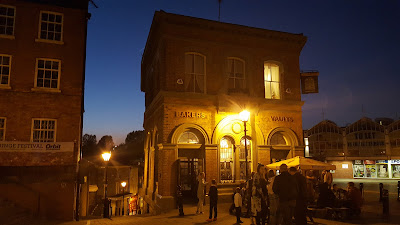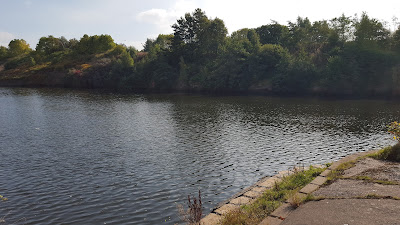This year was the inaugural Stockport Beer Week, organized by the Stockport and South Manchester branch of the Campaign for Real Ale (CAMRA) in collaboration with local CAMRA members, brewers, and Stockport's council. I'm a CAMRA member, and I love beer, so trying to make it out to some of the week's events was a no-brainer for me.
Stockport is only about 7 miles southeast of Manchester. Nowadays, that means it is all part of the jumbled sprawl that is the Greater Manchester metropolitan area, but back before the invention of cars, that was a far enough distance for Stockport to develop over the centuries as a town in its own right, with its own history and heritage.
It is actually faster for me to get from Altrincham to Stockport by train than it is for me to get to the city centre, but the trains only run once an hour, so it's just not as convenient. Hence, I hadn't really spent much time in Stockport prior to this. I bought my car at the Mercedes Benz dealer in Stockport, and I'd been to The Hope Inn once (The Hope is the home of the Fool Hardy Ales microbrewery). I've passed through the railway station, and I've driven through the town. Still, beer is always a good reason to explore a new area.
On Wednesday night (September 30), I met up with some beer buddies, and we started with an open house night at Cryptic Ales Brewery. The brewery is about 1 mile walking from the Stockport train station, so I got in some exercise first. The weather was exceptionally fine for a brisk walk. Cryptic has only been in operation for about a year, and this was their first official "open house". It had a really great space, and they had on some nice ales from their core range as well as a special ale brewed with ginger. The ginger wasn't overpowering and actually gave it a nice bite.
 |
| Beer Buddies |
 |
| Getting the obligatory "brewery tour" from Cryptic's brewer |
The brewery was unfortunately the target of a robbery very early on. The robbers broke in and stole all the equipment and electronics they could, and they still haven't been caught. The cheeky bastards took a black marker and wrote on the office wall -- "Thanks for the free stuff! :-)" The owners of the brewery have left the graffiti up there. The gall of it made me angry on their behalf. At least they were covered by insurance, but still, what an awful way to get your business off the ground.
After the brewery open house wrapped up, we started to walk back towards the centre of Stockport. We made a quick stop in at The Fairway Freehouse along with way. It wasn't part of the official Stockport Beer Week agenda, but one of my beer buddies is the brewer at Tatton Brewery, and The Fairway had some of his beer on, so he wanted to check the place out. Plus, a mile is a long way to walk without a beer. It was a very nice establishment with a charming, cozy interior and a good selection of fine ales.
We passed by the Stockport Town Hall, a local Edwardian landmark that is affectionately known as "the wedding cake" because of its ornate, tiered, white facade.
 |
| The Wedding Cake |
At this point, being a Wednesday night, I really should have caught the next train home. Instead, it was time to make a bad decision and go to the next pub. We ended the evening at The Spinning Top, a modern bar on the main thoroughfare of Wellington Road South that was going to have live music. Happily, they had some of Tatton Brewery's special "Ruck and Maul" Porter on, and our group polished off the cask. Tatton's "Ruck and Maul" was really, really good. The Spinning Top also had pork pies, and since I hadn't had dinner, I took down a cold pork pie with Branston Pickle and cheese. Delicious.
After we exhausted the cask ale options we liked, we did a couple of bottles. They had a Young's Double Chocolate Stout available, which is a wonderful beer. I'd only had it once before, and I was happy to find it again. I ended up catching the very last train home at 11:27 PM. Too much fun!
Friday, October 2 it was back to Stockport for Round 2 of Stockport Beer Week activities. This time, I headed past the Spinning Top and further northwest along Wellington Road South (the A6). This gave me my first chance to see the start of the River Mersey. The Rivers Tame and Goyt flow in from the east, and their confluence is the Mersey. Stockport is founded on three rivers. There even used to be a 3 Rivers Brewing (that didn't survive the great recession). As someone who lived in and loved Pittsburgh, Pennsylvania for 4 years, the confluence of three rivers parallel made me like Stockport even more.
 |
| The River Mersey, the Stockport Viaduct and a setting sun to the west. |
We started with a quick Happy Hour at the Crown Inn, a lovely heritage boozer with a large beer patio underneath the landmark Stockport viaduct. Again, the weather was very fine. Seriously, look at that unbelievable blue sky!
 |
| The Crown Inn with the iconic Stockport Viaduct in the background |
Next up, we walked over to Stockport Brewing for their brewery open house. Thank goodness I was with someone who knew where it was, because I never would have found it on my own. The brewery was tucked away into one of the arches of the viaduct, and you had to walk around the back of a building to get there. It was a tiny, quirky space, but their beer was good.
After about an hour, we walked over towards the town centre for a guided heritage walk, a History of Market Place Pubs. This was organized by a volunteer from the Stockport Heritage Trust, and it was really interesting and a lot of fun. I won't bore everyone with all of the historical bits, but it was cool.
 |
| The Market Hall building is really interesting. |
The old town centre of Stockport was built up on a hill, where there used to be a castle. Now there is the Market Hall building, surrounded on all sides by storefronts and pubs. Sadly, many of the storefronts today are in need of repair, and there are a number of vacant properties. The entire area has such tremendous potential; I hope they find a way to continue to revitalize it.
 |
| Under-utilized. |
 |
| One of the few lively places on the square and a fascinating history. Refurbished and upscale interior. |
 |
| Our walking tour guide. The walk was free; we just tipped him the cost of a pint. |
 |
| These old streets were designed for horse-drawn carriages and are called "brows". The views show how we're up on the top of a hill. |
 |
| The old Stockport dungeon and Court Leet, used until 1824. The tiny door is the drunk hole. If you were drunk and disorderly (or passed out), they would just throw you down into the dungeon through that door. |
The last stop of the night was The Magnet Freehouse, a 2015 CAMRA Pub of the Year. HELL YES. This place was fantastic.
 |
| For those who don't know, a Free House is not owned and controlled by a brewery, so it can serve any beers it wants. Brewery-owned pubs may have rotating guest taps, but a Free House will almost always have a more diverse and eclectic selection. |
The Magnet was packed with people. Fortunately, it was still nice enough to sit outside, and they had a back patio area with decks. They also had someone selling fresh, made-to-order pizzas out back, and I had probably the best pizza I have had since moving to the UK. That pizza was so good I was still thinking about it 3 days later. I'm drooling just thinking about it now. I have to go back to the Magnet, not only for the great beer selection and atmosphere, but also for more pizza.
 |
| Friday's cask and keg beer list |
I was in my happy place.
This year, I only got to do two of the Beer Week nights, but both nights were great, and I really enjoyed getting to know Stockport. From what I could see and the buzz that I heard, I think Stockport's Beer Week was a big success, and hopefully it will become an annual event for them.





























